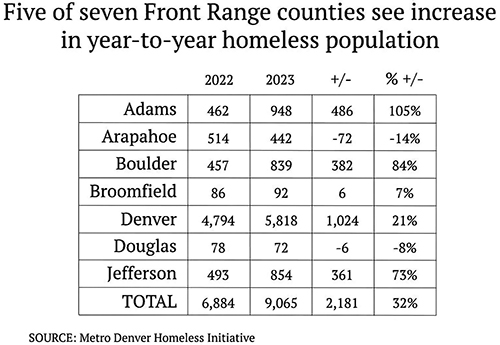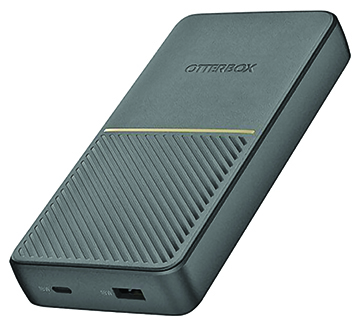
Power Bank Chargers: Three Products To Consider When Needing A Charge On The Go
by Mark Smiley

Reliable: The OtterBox Fast Charge is one of the fastest portable power banks on the market. This reliable brand is worth considering if in the market for a portable power bank.
Power bank chargers, also known as portable chargers or external battery packs, are portable devices designed to store electrical energy and then release it to charge various electronic devices such as smartphones, tablets, laptops, and more. These devices have become increasingly popular due to the high energy demands of modern gadgets and the need for a reliable source of power while on the go.
Power banks have become essential accessories for many people who rely on their electronic devices while on the go. When selecting a power bank charger, consider your specific needs and preferences to find the right one for you.
Three to consider purchasing for different reasons are the TravelCard Plus, OtterBox Fast Charge, and the CHAMP Portable Charger from Nimble.
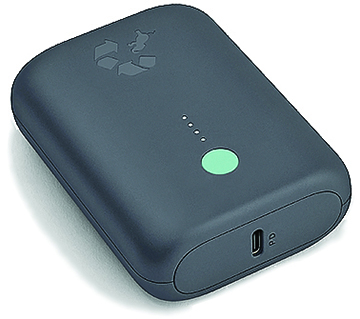
Ultra Compact: The CHAMP Portable Charger from Nimble features up to 80% charge in 30 minutes and can charge two devices simultaneously.
The physical dimensions and weight of the power bank can affect its portability. Smaller and lighter power banks are more convenient for daily carry, while larger ones may offer more capacity but can be less portable. One of the most slim and portable chargers is the TravelCard Plus. This portable charger is complete with built in charging cords and is compatible with iPhones and Android devices. The TravelCard Plus is approximately the size of a credit card and easily fits in your pocket for charging on the go.
It easily fit in my pocket on a dog walk to give the phone an extra boost. It contains a 1,500mAh battery, which does not offer a lot of horsepower but it makes up for it with it’s slim design and light weight at 1.6 ounces. Retailing at $39, the TravelCard Plus is a product that should be in your arsenal of power bank chargers. Visit www.travelcardcharger.com for more information or to purchase.

Slim Design: TravelCard Plus is slim and lightweight at 1.6 ounces. It is complete with built in charging cords and fits in your pocket with ease.
If you want more power and faster charging, the OtterBox Fast Charge is your ticket. It boasts a 20,000mAh battery. It does weigh nearly one pound so it isn’t necessarily the product that you would carry in your pocket. But, Otterbox has a reputation of designing and manufacturing good products and this is no exception. Power banks usually have multiple output ports to charge different devices simultaneously and the OtterBox Fast Charge offers this.
“I bought this so my daughter could charge her iPhone and air pods on road trips and airplanes,” said Ryan on Amazon. “It’s perfect. You get several charges on devices from this after it’s fully charged. The charge indicator is helpful to show how much charge it holds. It’s not so bulky where you can’t put it in a bag and bring it with you anywhere. It’s exactly what I was looking for and from a reliable brand. Highly recommend.” The OtterBox Fast Charge 20,000mAh retails for $54.95 and is another portable power bank to consider owning. Visit www.otterbox.com for more information.
Nimble’s CHAMP Portable Charger is the last power bank that is worth considering. It is perhaps the Goldilocks of portable chargers with a compact design, a weight of 6.4 ounces, and a 10,000 mAh battery for up to three days of power. It works with iPhone, iPad, Android devices, and more. This device is in my glove compartment for times when my phone needs an extra boost.
This device is also TSA approved and compact enough to throw in a backpack and take on the airplane. The CHAMP features up to 80% charge in 30 minutes and can charge two devices simultaneously. Also, Nimble is environmentally conscious as the packaging is made from recycled paper and uses no harmful inks or dyes. It is biodegradable and inside that packaging, you’ll find a bag that you can use to responsibly recycle your old electronic tech for free. The CHAMP retails for $49.95 and can be purchased at www.gonimble.com.
The price of power banks can vary widely based on capacity, features, and brand. While it’s important to stay within your budget, consider investing in a quality power bank from a trusted manufacturer to ensure long-term reliability. These three options are all in the $50 range and you can’t go wrong owning all three.

Electric Scooters: An Easy And Efficient Mode Of Transportation
by Mark Smiley
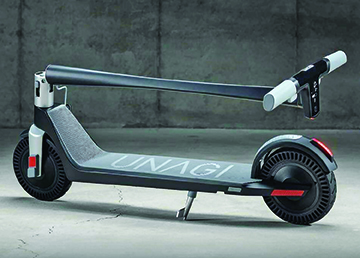
Unagi is known for their sleek and high-quality electric scooters designed for urban commuting and personal transportation. The Model One is portable and easy to use.
Electric scooters, often referred to as e-scooters, are small, two-wheeled vehicles that are powered by electric motors. They have become increasingly popular for urban transportation in recent years.
E-scooters are equipped with electric motors that provide propulsion. These motors are typically mounted in the scooter’s rear wheel. They are powered by rechargeable lithium-ion batteries. The capacity of these batteries determines the scooter’s range, which is the distance it can travel on a single charge.
Many electric scooters are designed to be foldable, making them portable and easy to carry. This feature is especially convenient for users who need to combine scooter travel with walking or public transportation.
Electric scooters have handlebars with hand grips, throttle controls, and brakes. Riders stand on a platform with one foot on each side of the front wheel. Electric scooters are commonly used for short trips within urban areas. They can be a convenient and eco-friendly mode of transportation for commuting, running errands, or exploring a city.
Most people are familiar with the sharing services in Denver. Companies such as Lime operate fleets of electric scooters that can be rented via smartphone apps. Users can find and unlock available scooters, ride them to their destination, and then leave them for the next rider.
But, have you ever considered owning one of these products? One brand to consider is Unagi. Unagi is known for their sleek and high-quality electric scooters designed for urban commuting and personal transportation. Unagi scooters are designed with a focus on both form and function, featuring a minimalist and aesthetically pleasing design while offering impressive performance and features.
As mentioned earlier, Unagi offers a foldable design and long battery life. The scooter does not have a removable battery but charging it to 100% takes less than two hours. The Unagi Model One Classic retails for less than $1,000 and comes in your choice of five different colors.
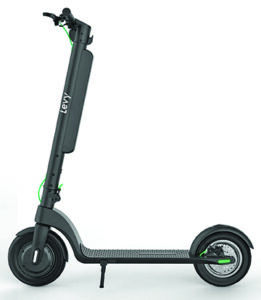
The Levy Plus E-Scooter has a range of 20 miles and can also reach speeds over 18 mph. The triple braking system makes it one of the safest on the market.
Unagi places a strong emphasis on design aesthetics, using high-quality materials and finishes to create a premium look and feel for their scooters. The Model One is a simple scooter to ride and lasts for hours with an easy-to-read dashboard, smooth braking, and impressive speeds. In our tests, the Unagi Model One reached 18 mph which is fast enough for most users. For more information or to purchase, visit unagiscooters.com.
Another scooter to consider is the Levy Plus which has a range of 20 miles and can also reach speeds over 18 mph. It is also portable as it folds and weighs a total of 30 pounds. The Levy Plus features cruise control which is a nice feature when cruising down the street while paying attention to traffic.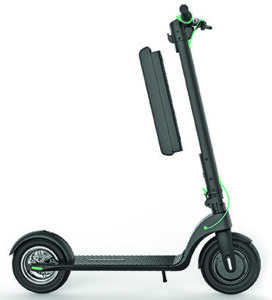
The triple braking system includes a front e-brake, rear disc brake system, and a rear fender brake for backup. The LED front and rear lights allow for nighttime riding while remaining visible and safe. On our test, we were impressed with the shock absorption. It performed nicely on the streets of Denver. It also has 10 inch tires which makes it suitable to handle rougher situations — like gravel paths and dirt roads.
All Levy scooters come with a six-month warranty and this particular model retails for $729. For more information or to purchase, visit www.levyelectric.com.

False Unit Figures Fueling Homeless Crisis, City Audit Finds
New Audit Reveals Denver Is Delivering Fewer Units Than Required, Costs Climb For Taxpayer-Funded Affordable Housing
by Glen Richardson
As 2024 begins, residents want to know if Mayor Mike Johnston met his $50 million promise to move 1,000 of Denver’s homeless off the streets by year’s end. Many others — like Councilmember Stacie Gilmore, who resigned as homeless committee chair — have concluded the administration’s homeless pledge is nothing more than “a dog and pony show.”
Facing the facts: Denver has the nation’s 10th-most homeless people. At year’s end there were 802 homeless people getting monthly payments of from $50 to $1,000. One group receives $1,000 a month for 12 months; another received a $6,500 lump payment and then $500 a month for 11 months; and the final group receives $50 a month for a year. For this year (2024), Mayor Johnston proposes to spend $242 million on homeless-affordable housing.
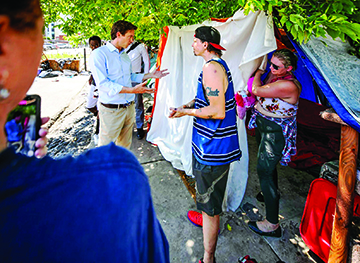
Street Sweep Scene: Denver continues to perform “sweeps” of homeless encampments under new Denver Mayor Mike Johnston. Photo: Kevin J. Beaty
A new financial examination by Denver Auditor Timothy M. O’Brien, however, reveals that finding housing or giving out money — without managing inherent and built-in factors — may b

Street Squalor Struggle: Despite providing money, plus developing and prioritizing affordable housing projects, Denver’s homeless crisis continues to surge as 2024 begins. Photo (left): Hart Van Denburg/CPR
e an emotional feat, but won’t accomplish the city’s objectives.
Unit Count Con
The audit’s most glaring discovery: Denver’s Department of Housing Stability is not delivering the required number of units. Fact: Denver developed 32 fewer units for very-low income and 301 fewer for moderate-income households than required by the city agreement.
Equally disturbing: The agency reported 203 units for rent at “market rates,” claiming they count as part of the agreement to develop affordable housing.
Lack of oversight is to blame, according to Auditor O’Brien. “If affordable housing is a priority, leaders need to effectively use resources, show accountability for housing goals, and commitment to helping those in Denver who need it m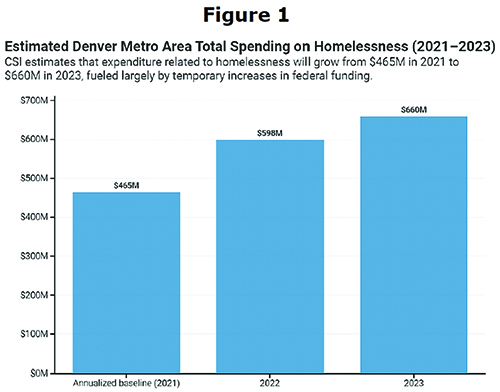 ost,” he asserts.
ost,” he asserts.
Shoddy Upkeep
Auditors also found a lack of oversight to maintain safe-habitable housing units for people in the lowest income ranges. Not only are these people subject to health-safety risks, but the city could lose part of its affordable housing inventory due to damage and disrepair.
A random check of 20 affordable housing projects funded by the Department of Housing Stability — plus an affordable housing project used as permanent housing and funded with program funds — examiners found building doors unlocked or propped open; doors missing handles; water damage; pet or human waste in public areas; plus, trash and debris.
More: Broken windows; dirty or damaged carpets; potential fire code violations, which were reported to the fire department; large cracks and other damage to exterior brick or foundations; evidence of pest infestations; exposed electrical wires or damaged electrical features; window and screens missing or damaged; inoperable or malfunctioning elevators; standing water in public areas; and damaged interior and exterior lighting.
Fewer New Units
Even more troubling, auditors found plans for new units are falling below requirements in the city’s taxpayer-funded agreement with the Denver Housing Authority. Denver partners with the Denver Housing Authority on their “DHA Delivers for Denver Program” — commonly called “D3.”

Broadway’s Best: Purchased by the Denver Housing Authority and completed in 2022, this 655 Broadway Bldg. rents to income limited elderly and disabled.
The audit discovered the housing authority reported some units were being rented at market rate, instead of at affordable rates for people with low-income levels.
Moreover, the housing authority also developed fewer units for low-and moderate-income individuals than required. Bottom line: Investments may and many times exceed what was agreed upon. There is no clarity on how many housing units will be delivered or if the units will be affordable for people who need it most. “The city needs stronger oversight to confirm the affordable housing results it promises,” says Auditor O’Brien. “It’s clear the city is too trusting in third-party partners and as a result the people who need the most help could be left out.”
Half Have High Rent
Just as shocking and upsetting, the audit reveals that half of the units in the city’s D3 agreement exceed the rents allowed by that agreement.
The housing authority reported 203 market-rate units paid for by the city’s D3 agreement were rented for between 60% and 90% of area median income. The housing authority claims this counts toward contract requirements because they are lower than the average rental prices in Denver, which are about 120% of the area median income.
While about half of these ar

Loose Connections: Audits of 20 affordable housing projects funded by the Department of Housing Stability found shoddy upkeep, including exposed-damaged electrical wires.
e rented at rates for people in the target income, the lower-than-average prices are not guaranteed if market conditions change — resulting in potential rent increases and loss of affordability.
District Deals
Additionally, some City Council districts are receiving more affordable housing resources than allowed. Specifically, districts 1, 3, 8, and 9 all received more affordable housing funds than allowed.
Further, district 3 was restricted to receiving fewer funds than other districts because of existing affordable housing investments. While the agreement allows the department to grant a waiver to any one district, except district 3, discussions about waivers are ongoing.
The housing authority is also counting units developed with “different city funding sources” as part of the D3 project, further inflating the results.
Clinch & Confirm
Finally, the audit found several other areas in which the city can make improvements to maintain and improve the city’s affordable housing struggle.
First, the city is not ensuring contractors are complying with wage laws on affordable housing projects. These projects may be subject to federal wage requirements or the city’s prevailing wage ordinance.
The Department of Housing Stability also needs to verify income annually for residents. The department also needs adequate
controls over its data, including what is used to populate public dashboards.
The Department of Housing Stability has agreed to implement nearly 90% (17 of the 19) of the audit recommendations.
It is disappointing, however, that the department chose to disagree with two of the audit recommendations. Those proposals would significantly improve the city’s inspection and maintenance of homeless units. Furthermore, it would ensure affordable housing is sanitary and safe.
The audit found issues at 14 of 21 homeless properties, despite inspection forms from the city showing no issues at the same properties.






